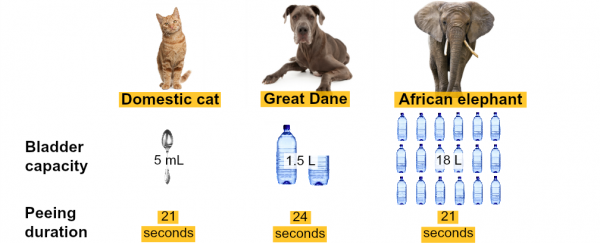Research has revealed that, regardless of size, all mammals larger than rats take roughly the same amount of time to urinate - 21 seconds.
In fact, as the infographic above shows, an African elephant can actually empty its 18 Litres of urine onto the ground in less time than a Great Dane empties its pitiful 1.5-Litre bladder. Don't even mention the fact that a cat only has a teaspoon of pee to get rid of in the same timeframe.
The research, led by David Hu, a mechanical engineer at the Georgia Institute of Technology in Atlanta, US, discovered that this universal urination timeframe is a result of our urethra - the tube that connects our bladders to the outside world - being designed as a "flow-enhancing device".
To study how long animals take to pee across the animal Kingdom, Hu turned to Zoo Atlanta and YouTube, where his team closely examined 34 different species of animals urinating. At Zoo Atlanta, the team also collected the urine of 16 species in empty bottles.
The team found that animals that are lighter than around 3 kilograms, such as rats and bats, don't pee in streams like other mammals - instead they urinate by spraying out a series of quick drops.
But larger animals, from goats and gorillas to elephants, all release jets and sheets of urine when they need to go - a process that lasts around 21 seconds regardless of size.
"It's like emptying a swimming pool [and] a bathtub in the same time," Hu told Megan Gannon at LiveScience, when the results were published in the Proceedings of the National Academy of Sciences back in July.
The controlling factor of urination duration is the length of the urethra, which gets longer at a predictable ratio as an animal gets bigger, the researchers found.
"All animals have urethras of the same aspect ratio: a length-to-width ratio of 18," Hu told Gannon. "This is rare among animals. Usually, body parts change in relative size, such as the eyes and brain."
As the urethra gets longer, the effects of gravity increase and there's more pressure pushing out the urine.
This isn't only fascinating research because, well, we all pee, it could also help engineers design better methods of draining large areas of water.
"We realised that this phenomenon had no size limit," Hu explained to Gannon. "Animals use it for 5 mL or 18 L bladders, but there is no reason that it could not be extended to larger systems like swimming pools."
While you guys think about the possibilities, we'll be timing ourselves in the bathroom to see just how effective our own urethra lengh-to-width ratio is.
Source: LiveScience
